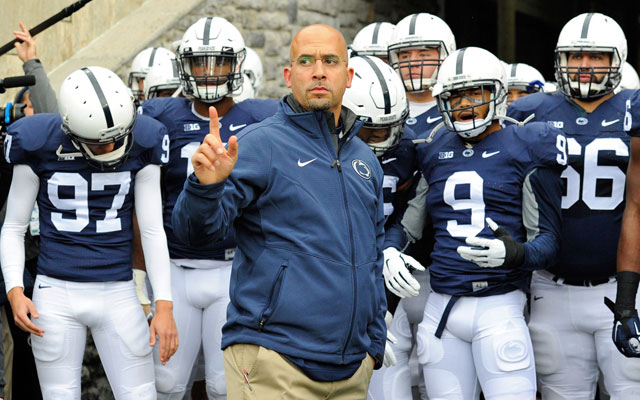
The College Football Playoff has a numbers problem.
As in, not enough of them.
The exclusion of Big Ten champion Penn State makes the strongest case yet that a four-team playoff is inadequate and needs to be expanded. Eight teams would allow a spot for each of the Power Five conference champions and leave room for other deserving teams, muting arguments like the ones that raged Sunday.
“That’s the hard part. We sat in there as a team and listened to all the points being made. You can make arguments for and against for so many teams,” Penn State coach James Franklin said on ESPN after the Nittany Lions were snubbed.
Franklin was as gracious Sunday as he was Saturday night after Penn State erased a 21-point deficit to beat Wisconsin for its ninth consecutive win, the third-longest winning streak in the country. The Big Ten champs will play in the Rose Bowl instead of facing No. 1 Alabama, so some would say the Nittany Lions actually fared better than if they’d made the playoff.
But that’s not the point.
The Big Ten had three teams in the top six of the playoff committee’s final rankings, cementing its status as the best conference this season. Yet its champion didn’t make the playoff, though a Big Ten team it beat did.
“The amount of teams that were worthy of this,” Ohio State coach Urban Meyer said. “… I can name six, seven teams right now that are that quality of team.”
No one doubts the sincerity or the diligence that the committee puts into the selection process. The four teams that made the playoff — Alabama, Clemson, Ohio State and Washington — are all deserving. But these are subjective decisions, and strong arguments can be made that Penn State, Michigan, even Oklahoma are worthy, too.
“The purpose, the mission of the selection committee is to get the four very best teams in the country,” chairman Kirby Hocutt said. “There are many factors that go into that discussion.”
The committee has not been consistent, though, in the importance it places on various criteria shifting from year to year. Is it conference championships that matter most, as the committee had indicated two years ago before reversing course this year? Strength of schedule? Head-to-head matchups? An eye test that can’t be quantified?
And how to account for the vagaries in conference alignment and scheduling over which the teams have no control?
“Every year is going to be different. Football seasons are like snowflakes, they’re all different,” College Football Playoff executive director Bill Hancock said. “Next year we’ll be standing here talking about some other way it fell out. And that’s great.”
By doubling the field, the committee’s choices would still be significant. They just wouldn’t have the Darwinian impact they do now.
The naysayers surely would howl about adding another game to the schedule and diluting the bowl system — the same excuses they used in resisting a playoff for all those years. Yet three years in, the playoff has been nothing short of a rousing success and a larger one would only double the fun.
To get the extra game, eliminate the conference championship games that were shown to be expendable this year. The angry arguments about who’s in and who’s out would be replaced by healthier, though no less passionate, debates over seeding and assigned sites. The prospects of playing Alabama in Atlanta loom larger when there are three other sites instead of one.
“When we started the playoff, people said this will grow to the game. I said, `This game is already off the charts in popularity,’ ” Hancock added. “But we have proven that this college football tree can grow. Indeed, grow to the sky.”
To grow, though, trees need room to branch out. So, too, the playoff.
By Nancy Armour
This article was republished with permission from the original author and 2015 Ronald Reagan Media Award recipient, Nancy Armour, and the original publisher, USA Today. Follow columnist Nancy Armour on Twitter @nrarmour.